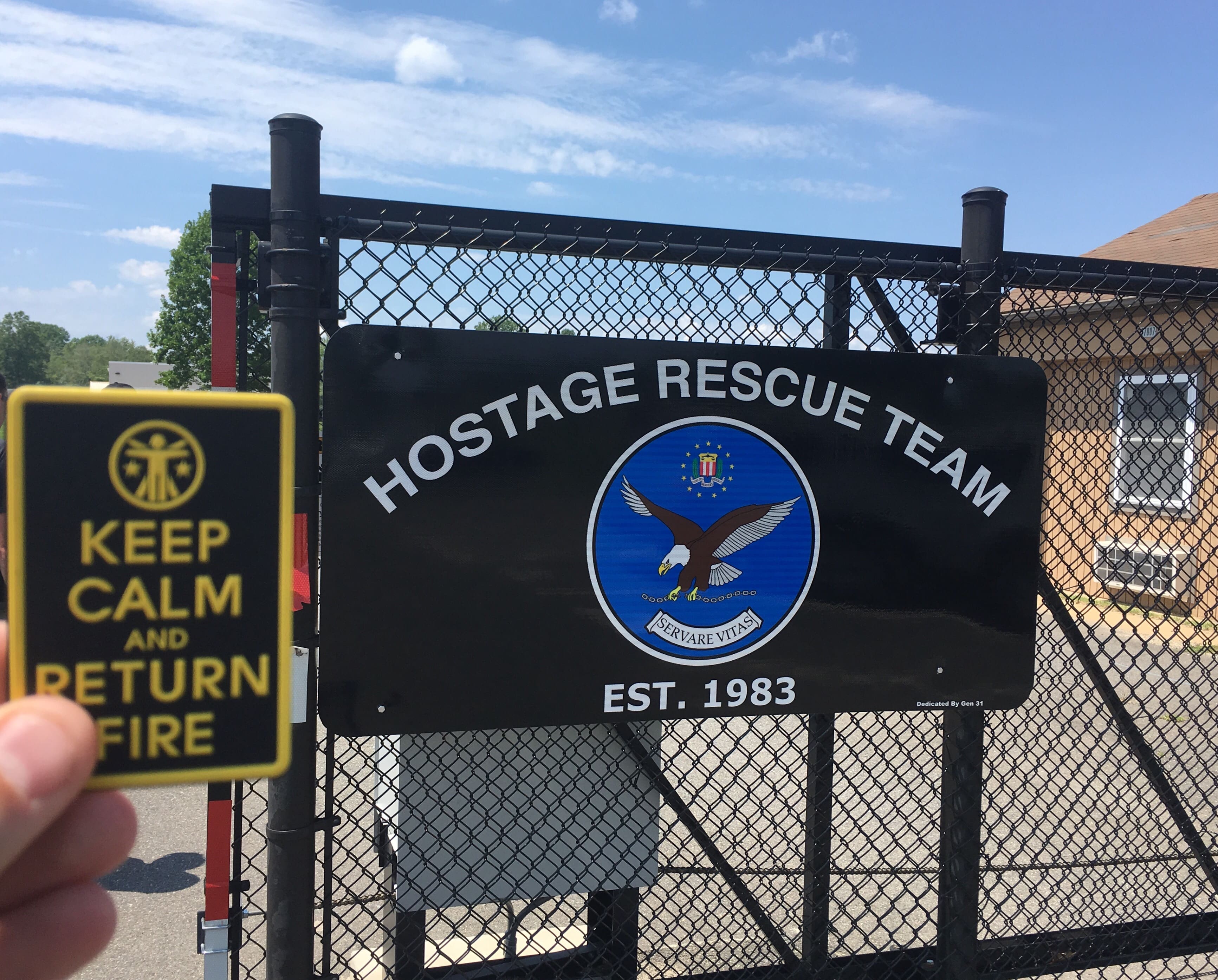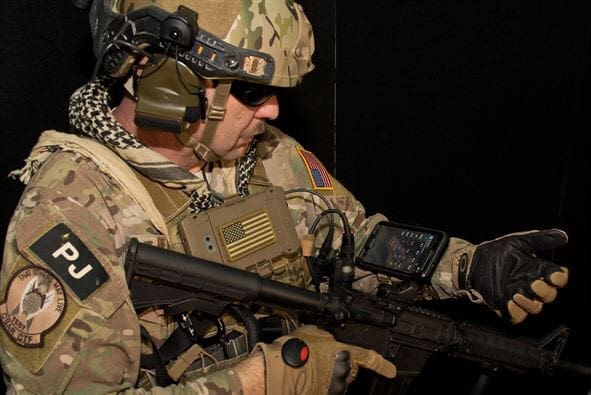It is located outside of the Harlow Police Station in Essex. The photo wasn't taken by a concerned party, aghast by the shear existence of such a device, but rather was posted to Facebook by the Essex Police, who are quite proud.

It is located outside of the Harlow Police Station in Essex. The photo wasn't taken by a concerned party, aghast by the shear existence of such a device, but rather was posted to Facebook by the Essex Police, who are quite proud.

Urgent operational usage of commercial electronic equipment is nothing new. Early in the GWOT, FRS “walkie talkie” equipment was frequently purchased by individual troops or with unit funds to address a shortage of comms at the squad level. Later, theater orders were issued prohibiting their usage due to grievous OPSEC/COMSEC issues and this shortfall was addressed with TPE (theater provided equipment) issue of ICOM and other commercial radio systems.
In a similar vein, Army organizations have procuring commercial hobbyist UAV systems to provide situational awareness and ISR capabilities “on the cheap.” However, such systems introduce a multitude of operational and cyber vulnerabilities. For the most common systems made by DJI, telemetry, audio, video, and locational data is sent back by default to the Chinese manufacturer.
On 2 August, the US Army prohibited the use of DJI drones:
DEPARTMENT OF THE ARMY
OFFICE OF THE DEPUTY CHIEF OF STAFF, G-3/5/7
400 ARMY PENTAGON
WASHINGTON, DC 20310-0400
DAMO-AV
MEMORANDUM FOR RECORD
2 August 2017
SUBJECT: Discontinue Use of Dajiang Innovation (DJI) Corporation Unmmaned Aircraft Systems
1. References:
a. Army Research Laboratory (ARL) report, “DJI UAS Technology Threat and User Vulnerabilities,” dated 25 May 2017 (Classified).
b. Navy memorandum, “Operational Risks with Regards to DJI Family of Products,” dated 24 May 2017.
2. Background: DJI Unmanned Aircraft Systems (UAS) products are the most widely used non-program of record commercial off-the-shelf UAS employed by the Army. The Army Aviation Engineering Directorate has issued over 300 separate Airworthiness Releases for DJI products in support of multiple organizations with a variety of mission sets. Due to increased awareness of cyber vulnerabilities associated with DJI products, it is directed that the U.S. Army halt use of all DJI products. This guidance applies to all DJI UAS and any system that employs DJI electrical components or software including, but not limited to, flight computers, cameras, radios, batteries, speed controllers, GPS units, handheld control stations, or devices with DJI software applications installed.
3. Direction: Cease all use, uninstall all DJI applications, remove all batteries/storage media from devices, and secure equipment for follow on direction.
4. Point of Contact: Headquarters, Department of the Army G-3/5/7 Aviation Directorate, 703-693-3552
JOSEPH ANDERSON
Lieutenant General, GS
Deputy Chief of Staff, G-3/5/7
Exploitation of data collected by these drones can provide an adversary with a inductive picture of friendly force operations, locations, and tempo. Much like watching surges in pizza deliveries to headquarters buildings at night, an adversary can infer forward operations by spikes in data traffic.
While the technical specifics are beyond the scope and span of SSD, this decision is still quite relevant to our readership.
For further information, check out this article from our peers at SUASnews.
It seems like we've all been waiting with bated breath for Altama's new line of Maritime Assault Boots to hit the market, but they finally made it.

With Uppers made from 1000D Cordura, they are fin friendly and incorporate mesh drain holes. The sole system includes a removable Ultron PU insole, full-length one-piece ABS shank for stability and support when climbing a caving ladder, and sticky SEAL Rubber outsoles with a Panama tread pattern.

They are offered in MultiCam, Black and Coyote. These are full-size shoes (7-14) with no half-sizes, so it's best to size up.
So far, O P Tactical has the low top model in stock. Look around the web and you should be able to find the mid-top soon as well.
www.optactical.com/alotbmaaslow

Newington, NH (August 4, 2017) – In response to social media rumors questioning the safety of the P320 pistol, a variant of which was selected by the U.S. government as the U.S. Army’s Modular Handgun System (MHS), SIG SAUER, Inc. has full confidence in the reliability, durability and safety of its striker-fired handgun platform. There have been zero (0) reported drop-related P320 incidents in the U.S. commercial market, with hundreds of thousands of guns delivered to date.
The P320 meets and exceeds all U.S. standards for safety, including the American National Standards Institute (ANSI) and Sporting Arms and Ammunition Manufacturers’ Institute, Inc. (SAAMI), as well as rigorous testing protocols for global military and law enforcement agencies.
All SIG SAUER pistols incorporate effective mechanical safeties to ensure they only fire when the trigger is pressed. However, like any mechanical device, exposure to acute conditions (e.g. shock, vibration, heavy or repeated drops) may have a negative effect on these safety mechanisms and cause them to not work as designed. This language is common to owner’s manuals of major handgun manufacturers.
As a result, individual attempts to perform drop tests outside of professionally controlled environments should not be attempted.
“SIG SAUER is committed to producing only the finest products,” said Ron Cohen, President and CEO of SIG SAUER. “Safety and reliability have been and always will be paramount to the SIG SAUER brand.”
For more information on SIG SAUER, please visit us at sigsauer.com.

FAIRFAX, Va. – The NRA Foundation awarded a total of $22,500 in college scholarships to attendees of the 2017 NRA Youth Education Summit (Y.E.S.), a seven-day educational experience in Washington, D.C., for rising high school juniors and seniors, held this year from July 24-30.
The Youth Education Summit encourages young adults to become active and knowledgeable U.S. citizens by learning about the Constitution, Bill of Rights and the federal government. Since the program’s inception in 1996, more than $540,000 in scholarships has been awarded to participants. The following students received scholarships based on their display of leadership qualities and performance in debates and speeches conducted over the course of the week.
2017 Y.E.S. End-of-Week Scholarships:
$3,500: Rylie Pennell, Warrenton, Virginia
$3,500: Simon Sefzik, Ferndale, Washington
$2,500: Denise Shaffer, Houston, Texas
$2,500: Peter Leonard, Tallahassee, Florida
$2,500: Allen Slaughter, Frankfort, Kentucky
$2,000: Kaitlyn Callaway, Tuscola, Texas
$2,000: Gage Paris, Black Forest, Colorado
$1,000: Sophia Puliafico, Juneau, Alaska
$1,000: Amby Tierney, Cohasset, Massachusetts
$1,000: Krzysztof Gajda, Rockford, Illinois
$1,000: Cristina Lee, Gilbert, Arizona
Funding for Y.E.S. week and Y.E.S. scholarships is provided by The NRA Foundation through funds raised at Friends of NRA events. Visit yes.nra.org for more information.

Chief Master Sgt. Robert Bean, an Air Force pararescue jumper, demonstrates how BATDOK can be worn on the wrist, providing awareness of the health status of multiple patients. Developing BATDOK required Air Force medical researchers to embed with pararescue jumpers on live missions to ensure the tool met the rigorous standards required by combat Airmen.
FALLS CHURCH, Va. — Imagine the chaos and challenge of delivering life-saving care in a battlefield environment. That’s what faced a group of Air Force researchers as they developed a new electronic patient monitoring tool for use on the battlefield. Overcoming this challenge required an integrated development process, where the researchers left the lab, and embedded on missions with medical Airmen.
The technology they developed, the Battlefield Assisted Trauma Distributed Observation Kit, or BATDOK, is software than can run on a smartphone or other mobile devices, and draws patient information from a wide variety of commercially available, U.S. Food and Drug Administration approved sensors. It lets medics monitor multiple patients in the field, seeing vital information and managing multiple patients in a chaotic environment.
The integrated development process was critical to making BATDOK a tool that seamlessly integrates mobile capabilities for Airmen in the field, said Dr. Gregory Burnett, of the Airman Systems Directorate in the Warfighter Interface Division of the 711th Human Performance Wing. Dr. Burnett managed the development of BATDOK for the Air Force.
“BATDOK is a multi-patient, point of injury, casualty tool that assists our human operators and improves care,” said Burnett. “It can be a real-time health status monitoring for multiple patients, a documentation tool, a user-definable medical library, a portal to integrate patient data into their electronic health records, and finally it is interoperable with battlefield digital situation awareness maps, which helps identify the exact location of casualties.”
Dr. Burnett’s background is in computer engineering, with an emphasis in embedded electronics and mobile interfaces. This theoretical knowledge helped the Air Force Research Laboratory development team design the look and feel of BATDOK, but more intimate knowledge was needed for the tool to be most useful for operators in the field.
“We physically left the lab, got into the field with the operators, and observed firsthand the challenges and deficiencies they face,” said Burnett. “And when I say into the field, I mean we literally rode in the helicopters into hot landing zones, and observed medical Airmen stabilize and package up patients for transport and load them back on the helicopter.
“We see, at the point of injury, the challenges and limitations that our medical Airmen face. With those lessons learned and gaps identified through direct experience, we come back to the lab and devise innovative solutions to address the short falls we observed firsthand in the field.”
The integration didn’t stop once the BATDOK development team got back to their lab. They continued to interact with the operators from their deployment, and got their feedback throughout the process.
“From day one, every interface, every button, every menu, was user-validated by pararescue Airmen and combat rescue officers that were involved in the design, integration and testing process,” said Burnett. “Nothing is added without the explicit request and review by the operator.”
This brings first firsthand knowledge to the development process. The development team and the operators sit down and walk through the mission step-by-step. They identify areas where current technology can be improved, or where a gap exists, and then share ideas to innovate new solutions and capabilities.
This process helps the team identify requirements and avoid unforeseen downsides to new technology. Medical Airmen deploy with heavy loads, so can be cautious about adding new gear. Working so closely with the operator helps the team integrate BATDOK into the tactical ensemble.
“BATDOK was designed to not add any additional burden to battlefield Airmen’s tactical ensemble,” said Burnett. “From the beginning, we are designing to enhance capabilities, while aiding their survivability and lethality.”
“Being part of the Air Force gives us flexibility and firsthand, unfiltered access to operators and perspective on the challenges that Airmen face. This is true for both humanitarian and combat missions. Being able to observe in person is invaluable, and helps us contribute to the overall readiness mission.”
By Peter Holstein, Air Force Surgeon General Office of Public Affairs
This past Friday, July 28, Blue Force Gear, the manufacturer of the world’s finest weapon slings and tactical equipment, released a Limited Edition AK Sling and there are less than 100 left in stock.
The Limited Edition AK Sling is the sixth edition to the Limited Edition AK Sling Line and touts never before released Ranger Green webbing. Inspired by the slings originally issued on Eastern Bloc AK-47s, this Limited Edition version Standard AK Sling was designed to be simple, durable, functional, and economical.
Built with a leather pull tab, the ULoop sling attachment component, and the quality you’ve come to expect from the Vickers Combat Application Sling™, this limited edition AK sling is nothing like you’ve ever seen before. The new sling can be purchased online for $65 at www.blueforcegear.com/ak-sling-v6.